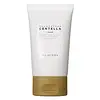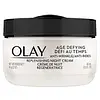What's inside
What's inside
 Key Ingredients
Key Ingredients

 Benefits
Benefits

 Concerns
Concerns

 Ingredients Side-by-side
Ingredients Side-by-side

Cetyl Ethylhexanoate
EmollientGlycerin
HumectantPentylene Glycol
Skin ConditioningHydrogenated Lecithin
EmulsifyingNiacinamide
SmoothingMacadamia Ternifolia Seed Oil
EmollientPEG-50 Shea Butter
EmulsifyingLimnanthes Alba Seed Oil
Skin ConditioningSqualane
EmollientCarbomer
Emulsion Stabilising1,2-Hexanediol
Skin ConditioningTromethamine
BufferingPanthenol
Skin ConditioningSodium Carbomer
Emulsion StabilisingErythritol
HumectantTrehalose
HumectantBetaine
HumectantButylene Glycol
HumectantCaprylhydroxamic Acid
Caprylic/Capric Triglyceride
MaskingAdenosine
Skin ConditioningLavandula Spica Flower Oil
MaskingXanthan Gum
EmulsifyingOzonized Olive Oil
Skin ConditioningHydroxyethylcellulose
Emulsion StabilisingOrange Roughy Oil
Skin ConditioningMadecassoside
AntioxidantBiosaccharide Gum-1
HumectantAsiaticoside
AntioxidantMalt Extract
Skin ProtectingAsiatic Acid
Skin ConditioningButter Extract
EmollientGlycyrrhiza Glabra Leaf Extract
Skin ConditioningCeramide AP
Skin ConditioningChamomilla Recutita Flower Extract
MaskingLinoleic Acid
CleansingEthylhexylglycerin
Skin ConditioningSodium Hyaluronate
HumectantLinolenic Acid
CleansingCetyl Ethylhexanoate, Glycerin, Pentylene Glycol, Hydrogenated Lecithin, Niacinamide, Macadamia Ternifolia Seed Oil, PEG-50 Shea Butter, Limnanthes Alba Seed Oil, Squalane, Carbomer, 1,2-Hexanediol, Tromethamine, Panthenol, Sodium Carbomer, Erythritol, Trehalose, Betaine, Butylene Glycol, Caprylhydroxamic Acid, Caprylic/Capric Triglyceride, Adenosine, Lavandula Spica Flower Oil, Xanthan Gum, Ozonized Olive Oil, Hydroxyethylcellulose, Orange Roughy Oil, Madecassoside, Biosaccharide Gum-1, Asiaticoside, Malt Extract, Asiatic Acid, Butter Extract, Glycyrrhiza Glabra Leaf Extract, Ceramide AP, Chamomilla Recutita Flower Extract, Linoleic Acid, Ethylhexylglycerin, Sodium Hyaluronate, Linolenic Acid
Water
Skin ConditioningGlycerin
HumectantIsohexadecane
EmollientNiacinamide
SmoothingDimethicone
EmollientIsopropyl Isostearate
EmollientPolyacrylamide
Titanium Dioxide
Cosmetic ColorantPanthenol
Skin ConditioningTocopheryl Acetate
AntioxidantRetinyl Propionate
Skin ConditioningEthylhexyl Salicylate
UV AbsorberAscorbic Acid
AntioxidantStearyl Alcohol
EmollientC13-14 Isoparaffin
EmollientLaureth-7
EmulsifyingDimethiconol
EmollientAmmonium Polyacrylate
StabilisingCetyl Alcohol
EmollientPolyethylene
AbrasiveAluminum Starch Octenylsuccinate
AbsorbentBehenyl Alcohol
EmollientBenzyl Alcohol
PerfumingCetearyl Glucoside
EmulsifyingCetearyl Alcohol
EmollientEthylparaben
PreservativeStearic Acid
CleansingPEG-100 Stearate
Propylparaben
PreservativeDisodium EDTA
Parfum
MaskingWater, Glycerin, Isohexadecane, Niacinamide, Dimethicone, Isopropyl Isostearate, Polyacrylamide, Titanium Dioxide, Panthenol, Tocopheryl Acetate, Retinyl Propionate, Ethylhexyl Salicylate, Ascorbic Acid, Stearyl Alcohol, C13-14 Isoparaffin, Laureth-7, Dimethiconol, Ammonium Polyacrylate, Cetyl Alcohol, Polyethylene, Aluminum Starch Octenylsuccinate, Behenyl Alcohol, Benzyl Alcohol, Cetearyl Glucoside, Cetearyl Alcohol, Ethylparaben, Stearic Acid, PEG-100 Stearate, Propylparaben, Disodium EDTA, Parfum
 Reviews
Reviews

Ingredients Explained
These ingredients are found in both products.
Ingredients higher up in an ingredient list are typically present in a larger amount.
Glycerin is already naturally found in your skin. It helps moisturize and protect your skin.
A study from 2016 found glycerin to be more effective as a humectant than AHAs and hyaluronic acid.
As a humectant, it helps the skin stay hydrated by pulling moisture to your skin. The low molecular weight of glycerin allows it to pull moisture into the deeper layers of your skin.
Hydrated skin improves your skin barrier; Your skin barrier helps protect against irritants and bacteria.
Glycerin has also been found to have antimicrobial and antiviral properties. Due to these properties, glycerin is often used in wound and burn treatments.
In cosmetics, glycerin is usually derived from plants such as soybean or palm. However, it can also be sourced from animals, such as tallow or animal fat.
This ingredient is organic, colorless, odorless, and non-toxic.
Glycerin is the name for this ingredient in American English. British English uses Glycerol/Glycerine.
Learn more about GlycerinNiacinamide is a multitasking form of vitamin B3 that strengthens the skin barrier, reduces pores and dark spots, regulates oil, and improves signs of aging.
And the best part? It's gentle and well-tolerated by most skin types, including sensitive and reactive skin.
You might have heard of "niacin flush", or the reddening of skin that causes itchiness. Niacinamide has not been found to cause this.
In very rare cases, some individuals may not be able to tolerate niacinamide at all or experience an allergic reaction to it.
If you are experiencing flaking, irritation, and dryness with this ingredient, be sure to double check all your products as this ingredient can be found in all categories of skincare.
When incorporating niacinamide into your routine, look out for concentration amounts. Typically, 5% niacinamide provides benefits such as fading dark spots. However, if you have sensitive skin, it is better to begin with a smaller concentration.
When you apply niacinamide to your skin, your body converts it into nicotinamide adenine dinucleotide (NAD). NAD is an essential coenzyme that is already found in your cells as "fuel" and powers countless biological processes.
In your skin, NAD helps repair cell damage, produce new healthy cells, support collagen production, strengthen the skin barrier, and fight environmental stressors (like UV and pollution).
Our natural NAD levels start to decline with age, leading to slower skin repair, visible aging, and a weaker skin barrier. By providing your skin niacinamide, you're recharging your skin's NAD levels. This leads to stronger, healthier, and younger looking skin.
Another name for vitamin B3 is nicotinamide. This vitamin is water-soluble and our bodies don't store it. We obtain Vitamin B3 from either food or skincare. Meat, fish, wheat, yeast, and leafy greens contain vitamin B3.
The type of niacinamide used in skincare is synthetically created.
Learn more about NiacinamidePanthenol is a common ingredient that helps hydrate and soothe the skin. It is found naturally in our skin and hair.
There are two forms of panthenol: D and L.
D-panthenol is also known as dexpanthenol. Most cosmetics use dexpanthenol or a mixture of D and L-panthenol.
Panthenol is famous due to its ability to go deeper into the skin's layers. Using this ingredient has numerous pros (and no cons):
Like hyaluronic acid, panthenol is a humectant. Humectants are able to bind and hold large amounts of water to keep skin hydrated.
This ingredient works well for wound healing. It works by increasing tissue in the wound and helps close open wounds.
Once oxidized, panthenol converts to pantothenic acid. Panthothenic acid is found in all living cells.
This ingredient is also referred to as pro-vitamin B5.
Learn more about Panthenol